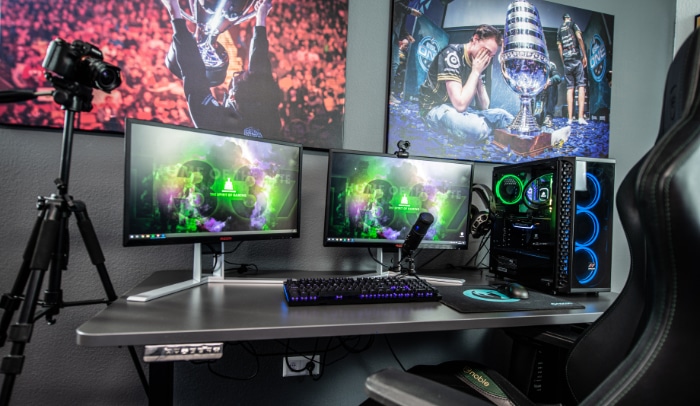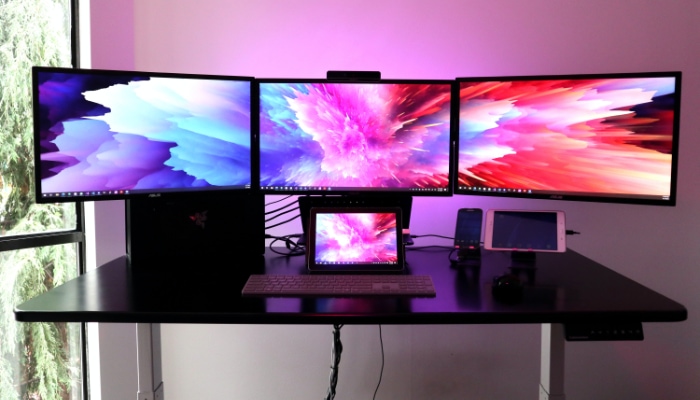Does Having a Second Monitor Affect Gaming Performance?

Multi-monitor setups have become increasingly popular among gamers and professionals alike. This trend has led to an ever-growing number of gamers adopting a second monitor to enhance their gaming experience. However, this has also sparked concerns and questions about how adding a second monitor may impact gaming performance.
In a world where high frame rates and smooth gameplay are crucial for an immersive experience, it's essential to understand whether a second monitor could potentially hinder gaming performance.
Benefits of a Second Monitor for Gamers
From enhanced multitasking capabilities to a more immersive gaming experience, a dual-monitor setup can significantly improve your overall gaming experience.
Streaming and Content Creation
A second monitor can significantly improve the streaming and content creation process for gamers. It allows streamers to keep an eye on their broadcasting software, chat with viewers, and monitor stream statistics, all while playing their game uninterrupted on the primary screen.
Communication with Friends or Teammates
A dual-monitor setup enables gamers to stay connected with their friends or teammates during gameplay. They can easily access communication platforms like Discord or TeamSpeak on the second screen without disrupting the gaming experience.
Access to Game Guides or Walkthroughs
For gamers who prefer to have game guides or walkthroughs at their fingertips, a second monitor can be a valuable resource. They can quickly refer to strategy guides, maps, or online forums without having to pause or minimize their game.
Wider Field of View
Certain games, particularly racing or flight simulators, can take advantage of a second monitor to create a wider field of view. This expanded perspective can provide a more immersive experience by increasing peripheral awareness and enhancing the overall visual appeal of the game.
Better Peripheral Awareness
In competitive games, having a second monitor can help players maintain better peripheral awareness, especially when using a dual-monitor setup that spans the game across both screens. This can give players an advantage in detecting enemies or other in-game events occurring outside their immediate field of view.
Seamless Transition between Tasks
Having a second monitor can help gamers maintain productivity during gaming sessions. They can easily switch between gaming and non-gaming tasks without disrupting their workflow, such as replying to emails or managing social media accounts.
Organized Workspace
A dual-monitor setup allows gamers to keep their workspace organized, as they can dedicate one screen to gaming and the other to any additional tasks or applications. This can help maintain focus and reduce the clutter that often comes with a single-screen setup.
Factors that Impact Gaming Performance with a Second Monitor
Before we analyze the effects of a second monitor on gaming performance, it's essential to understand the various factors that can impact gaming performance in a dual-monitor setup.
Graphics Card
The graphics card plays a crucial role in determining gaming performance, as it processes and renders the images displayed on your monitors. Adding a second monitor may increase the workload on your graphics card, depending on the applications and resolutions being used on both screens.
CPU
The CPU is responsible for processing various game-related tasks and sending instructions to the graphics card. While adding a second monitor may not significantly increase the load on the CPU, it's essential to ensure that your CPU can handle the demands of both gaming and any additional tasks running on the second screen.
RAM
Sufficient RAM is necessary for smooth gaming performance, as it stores the data required for running applications. The addition of a second monitor may increase the demand for RAM, depending on the applications being used simultaneously.
Resolution
The resolution of your game and monitors can impact gaming performance. Higher resolutions require more processing power from your graphics card, so it's essential to balance resolution settings between both monitors to optimize performance.
Texture Quality
The quality of textures in a game can also affect performance, as higher quality textures demand more resources from your graphics card. Adjusting the texture quality settings can help maintain smooth gameplay when using a second monitor.
Frame Rate
Frame rate, or frames per second (FPS), is a critical factor in gaming performance. A higher frame rate provides a smoother gaming experience, but it requires more processing power. Balancing frame rate settings between your game and second monitor applications can help optimize performance.
Monitor Refresh Rate
The refresh rate of your monitors can impact gaming performance. Higher refresh rates demand more processing power from your graphics card, so it's essential to consider this factor when adding a second monitor to your setup.
Connectivity Options
The connection type between your graphics card and monitors can also influence gaming performance. Some connection types, such as HDMI and DisplayPort, offer higher bandwidth and support for higher resolutions and refresh rates, ensuring optimal gaming performance with a second monitor.
How a Second Monitor Affects Gaming Performance

Now that we have explored the benefits of a second monitor and the factors that can impact gaming performance, it's time to delve into the specific ways a second monitor can affect gaming performance.
Video Memory Usage
Running a second monitor can increase the video memory usage of your graphics card. Video memory (VRAM) is used to store texture and image data for your games and applications. The more applications and higher resolutions you use across both monitors, the more VRAM is required, potentially affecting gaming performance.
GPU Processing Power
The GPU's processing power is responsible for rendering images and handling complex graphical tasks. When adding a second monitor, the GPU may need to allocate resources to handle the additional workload, which could impact gaming performance, especially if the GPU is already being pushed to its limits.
RAM Usage
Using a second monitor can lead to an increase in RAM usage, as the system needs to manage additional applications and tasks running on the second screen. Depending on the RAM capacity and the demands of the applications, this may or may not noticeably impact gaming performance.
CPU Utilization
While the addition of a second monitor may not significantly increase CPU utilization, it's essential to monitor the overall system load. Running CPU-intensive applications on the second monitor while gaming can potentially cause a decrease in gaming performance if the CPU struggles to handle the combined workload.
Performance Benchmarks
When comparing gaming performance, it's important to consider the difference in FPS between a single and dual monitor setup. In many cases, a properly optimized system may not experience a significant FPS drop when using a second monitor. However, it's essential to consider the specific hardware and game settings to ensure optimal performance.
Latency and Input Lag
The addition of a second monitor can potentially introduce latency or input lag if the GPU struggles to handle the increased workload. This can lead to a less responsive gaming experience. Balancing the demands of both monitors and optimizing settings can help minimize these issues.
Subjective Gaming Experience
Ultimately, the impact of a second monitor on gaming performance may vary depending on individual preferences and hardware capabilities. Some gamers may notice a minimal impact on their gaming experience, while others may need to make adjustments or upgrades to maintain their desired level of performance.
How to Optimize Gaming Performance with a Second Monitor
Having established the potential impact of a second monitor on gaming performance, we will now explore the various strategies and adjustments that can be made to optimize gaming performance with a dual-monitor setup.
Upgrading Hardware Components
To ensure optimal gaming performance with a second monitor, consider upgrading your graphics card to a model with sufficient processing power and VRAM. This will help maintain smooth gameplay and reduce the impact of the additional workload from the second screen.
Sufficient RAM and CPU
Ensuring that your system has adequate RAM and a capable CPU is crucial for maintaining gaming performance with a second monitor. Upgrading to a higher capacity RAM or a more powerful CPU can help handle the demands of multitasking and gaming simultaneously.
Adjusting Game Settings
To optimize gaming performance on a dual-monitor setup, consider lowering the graphics quality settings in your game. Reducing settings such as texture quality, anti-aliasing, and shadow quality can free up resources and help maintain a smooth gameplay.
Optimizing Game Settings for Multiple Monitors
Some games offer built-in settings to optimize performance for multi-monitor setups. Exploring these options and making adjustments can help ensure a better gaming experience with a second monitor.
Monitor Selection and Setup
When selecting a second monitor for gaming, consider factors such as refresh rate, resolution, and response time. Choosing a monitor with a high refresh rate and low response time can help minimize latency and provide a smoother gaming experience.
Conclusion
The impact of adding a second monitor on gaming performance can vary depending on several factors, such as hardware components, game settings, and individual preferences. However, with proper optimization and consideration, it's possible to maintain a smooth and enjoyable gaming experience while benefiting from the multitasking capabilities and immersive experience that a second monitor provides.
We have explored the key factors that influence gaming performance, such as graphics card workload, system resources, and performance benchmarks. By upgrading hardware components, adjusting game settings, and selecting the right monitor, gamers can optimize their dual-monitor setup for the best possible gaming experience.
Ultimately, it's essential to strike a balance between performance and the added benefits of a second monitor. With the right approach, gamers can enjoy the advantages of multi-monitor gaming without compromising their gaming performance.


